Japanese construction firm Shimizu Corporation has developed a series of bold architectural plans for the world of tomorrow. Here is a preview of seven mega-projects that have the potential to reshape life on (and off) Earth in the coming decades.
* * * * *
- Luna Ring
In response to the ever-growing demand for energy, Shimizu has developed plans for the Luna Ring, a project that seeks to transform the Moon into a massive solar power plant.
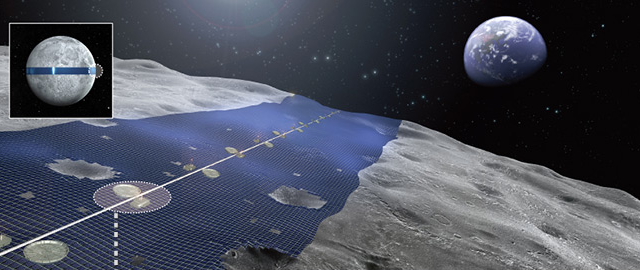
Luna Ring's 11,000-kilometer (6,800-mile) "solar belt" spans the Moon's equator
Electricity collected by the Luna Ring's enormous "solar belt" is relayed to power conversion facilities located on the near side of the Moon. There, the electricity is converted into powerful microwaves and lasers, which are beamed at Earth. Terrestrial power stations receive the energy beams and convert them back to electricity.

Luna Ring feeds power to energy-hungry Earth
The solar power plant is built mainly using lunar resources. Moon rocks and dust are used to manufacture building materials such as cement, bricks and glass fibers. Water is produced through a chemical process involving lunar soil and hydrogen.
Large machinery and equipment from Earth is assembled in space and landed on the lunar surface for installation. Much of the construction is performed by robots controlled by people on Earth, and a team of human astronauts is stationed on the Moon to supervise the robot operations. [More]
* * * * *
- Green Float
Shimizu's Green Float project seeks to build "botanical" cities that float like giant lily pads in the equatorial Pacific, where sunlight is plentiful and the impact of typhoons is minimal.

Lily pad-like cities at sea
Each floating island features a 1,000-meter (3,300-ft) central tower. The lower section of the tower serves as an industrial area with offices and factories employing 10,000 workers, while the upper section functions as a residential area for 30,000 people. Another 10,000 residents live at ground level, in low-rise townhouses near the beach.
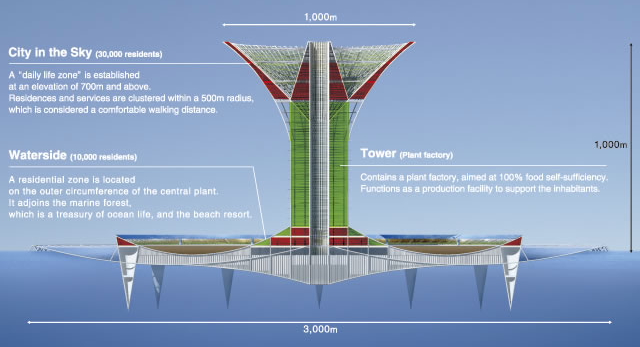
Green Float islands are 3 kilometers (1.9 mi) in diameter and support a population of 40,000
The typical Green Float island landscape consists of forests, grasslands, waterways and reservoirs. A portion of the land is set aside for agriculture and some of the shallow beaches are used for cultivating seafood, making the islands 100% food self-sufficient.
The eco-friendly Green Float cities rely on a variety of natural energy sources, including wave, wind and solar power, as well as ocean thermal energy conversion.
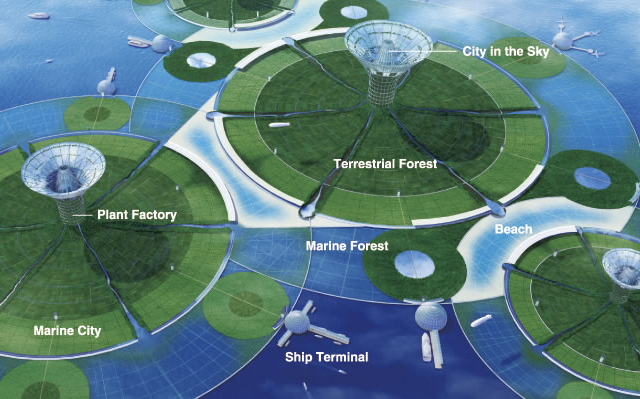
Green Float islands join to form a floating metropolis
Green Float islands are built upon a floating base of connected hexagonal tubes that each weigh 7,000 tons and measure 20 meters (65 ft) across and 50 meters (165 ft) deep. The primary structural material for the honeycomb-like base, as well as for the island's buildings, is magnesium alloy. Seawater -- which is composed of 0.13% magnesium by weight -- is an abundant source of magnesium. One ton of the material can be extracted from 770 tons of seawater. [More]
* * * * *
- Mega-City Pyramid
Shimizu's proposed Mega-City Pyramid is a self-contained city for one million people.

The Mega-City Pyramid stands 2,000 meters (1.25 miles) high
The pyramid-shaped hyperstructure is an assembly of skyscrapers suspended within a skeleton of 350-meter (1,150-ft) long shafts made from lightweight materials (such as carbon and glass fibers).
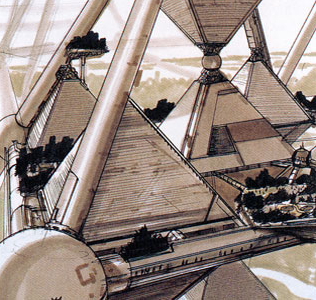
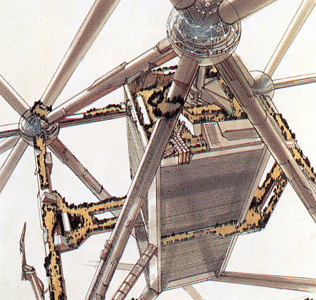
Residential buildings (left) and office complexes (right) inside Mega-City Pyramid
The skyscrapers within the Mega-City Pyramid are home to residences, offices, research institutions, shopping and entertainment centers, and other facilities. The connecting shafts, which measure from 10 to 16 meters (30 to 50 ft) in diameter, contain the city's plumbing, electrical and communication systems, as well as a network of trains, escalators and moving walkways.
+ Video
The proposed hyperstructure has a footprint of approximately 8 square kilometers (3 sq mi), and it features an open-air construction that allows sunlight to reach the interior. A network of optical fibers transports sunlight into poorly-lit areas.
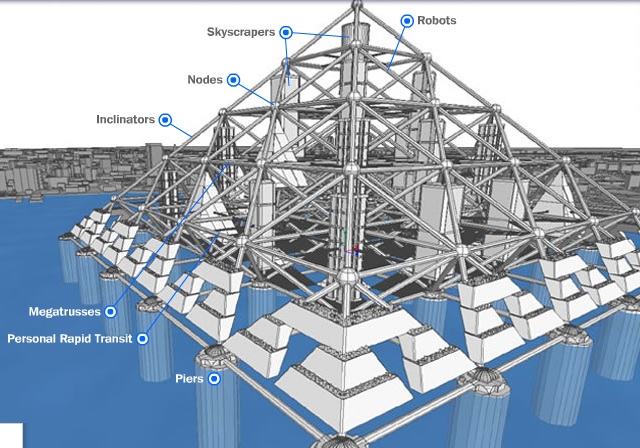
Construction of the massive Mega-City Pyramid is facilitated by robots and automated assembly systems, as well as by the use of standardized parts and materials. [More]
* * * * *
- Space Hotel
To capitalize on the coming boom in space tourism, Shimizu has developed plans for a space hotel in low-Earth orbit.
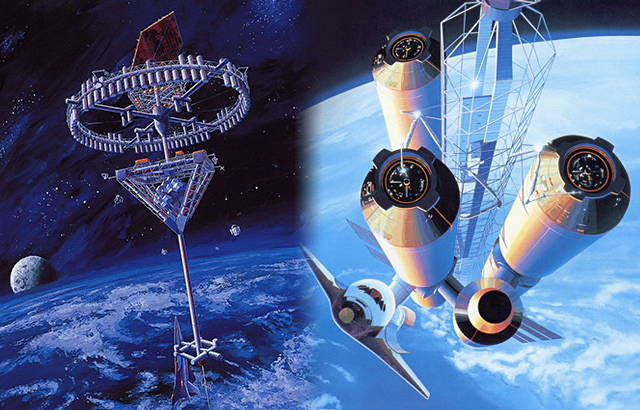
Shimizu Space Hotel, located 450 kilometers (280 mi) above Earth
The hotel -- which is powered entirely by solar energy -- features a microgravity recreational area where guests can enjoy sports, dining, and gazing at the Earth and stars. The 64 guest rooms and 40 staff rooms are situated in a ring measuring 140 meters (460 ft) in diameter. The ring rotates at a speed of 3 rpm to produce an artificial gravity of 0.7 g in the rooms. A 240-meter (790-ft) elevator shaft connects the hotel facilities with the docking port. [More]
* * * * *
- Lunar Bases
For the more adventurous offworld traveler, Shimizu has developed plans for lunar bases.
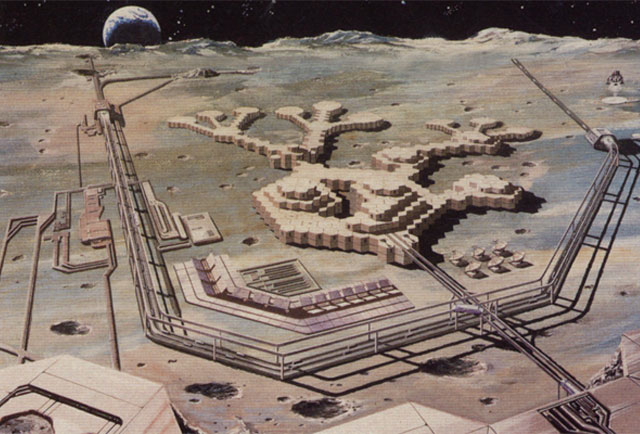
Lunar bases are the key to establishing a long-term human presence on the Moon
Shimizu's proposed bases feature a modular design of interlocking hexagonal units that can be arranged both horizontally and vertically. The modules are built using concrete made from lunar soil and rock. Tele-operated robots and automated assembly systems are used to construct the bases. [More]
* * * * *
- Urban Geo-Grid Plan
Back on Earth, Shimizu's Urban Geo-Grid Plan seeks to reduce urban congestion and improve the overall efficiency of Tokyo by placing a variety of city functions underground.
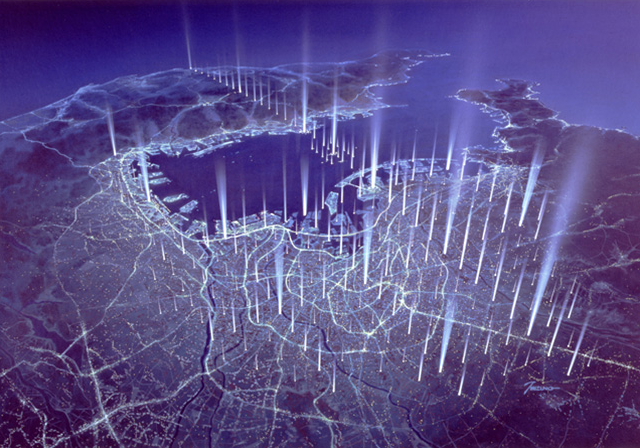
Urban Geo-Grid Plan puts much of Tokyo underground
The plan -- which covers an area extending from central Tokyo to the Boso Peninsula on the opposite side of Tokyo Bay -- consists of a vast underground network of so-called "grid points" and "grid stations." Grid points incorporate community facilities such as grocery stores, exhibition halls and public bathhouses, while the larger-scale grid stations incorporate office buildings, hotels, shopping centers, and train stations. An extensive underground transportation network connects the grid points and stations. Moving all these facilities underground frees up an enormous amount of street-level space that can be set aside for parks. [More]
* * * * *
- Desert Aqua-Net Plan
The Desert Aqua-Net Plan seeks to make the desert habitable by constructing a network of lakes and waterways.
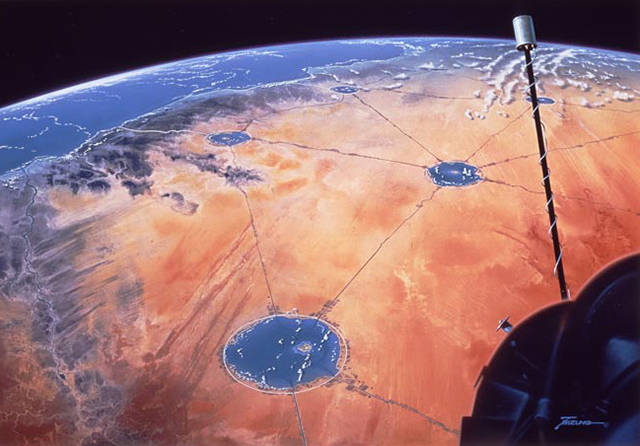
Desert Aqua-Net Plan brings water to the desert
The plan involves creating artificial lakes in low-lying desert areas. Islands are constructed in the middle of the lakes, which are filled with seawater channeled inland through canals. The canals connect the lakes to form an extensive water network.
Located 150 kilometers (95 mi) apart, the artificial lakes measure 30 kilometers (20 mi) in diameter and 20 to 30 meters (65-100 ft) deep. The canals running between the lakes measure 50 meters (165 ft) wide and 10 meters (35 ft) deep
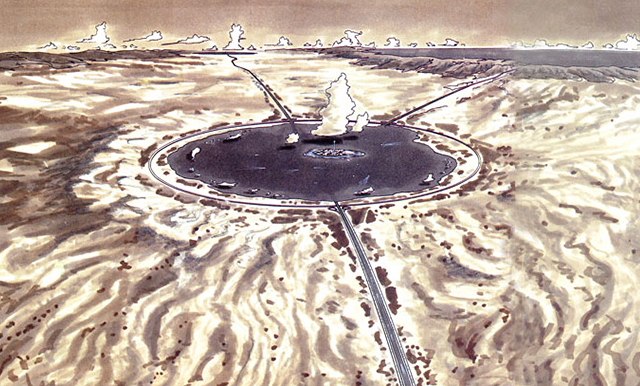
The lakes reduce temperatures and increase humidity in the surrounding areas, creating a comfortable and mild environment. Seafood and biomass resources (such as algae and seaweed) can be cultivated in the saltwater lakes, and the canals can be used to transport people and goods between the cities built on the artificial islands. [More]

Laboose
This is the most awe-inspiring article I've ever read!
I wonder if they will actually happen, and when they will be completed. It even one of these projects are completed, it'd be an epic feat by mankind.
Thanks for sharing!
[]Artur
Check it out, dude: http://www.thevenusproject.com
[]chrisse
don't forget the giant kraken if they settle the pacific
[]Lan
In this timid little age, I'm very happy to see that at least some people are still willing to dream!
[]AdelaideBen
The brave new world... now pass around the good stuff so that we can all enjoy. ?;^)....
[]It's good to have hopes, but I also hope they're not looking for financial backers - coz if they are, I know some great real-estate up in Queensland (Australia) that is beautiful beach-front property that's just waiting to be discovered. Mega-city here we come!
Jesse Chisholm
No Koolaide necessary. :)
Projects this big will likely require bureaucracies the size of governments. And taxes is how they tend to get their coffers filled.
But if we as a species decided to back these kinds of ideas, would $1 USD per person per year planet wide be too much to spend? That's nearly $7B USD each year. To governments, that's pocket change. It will probably cost more than that (especially if try to do them all), but my point is that the cost per person need not be high.
Much costlier is convincing the people that we should make this kind of long term commitment. And then sticking to it long enough to complete the projects.
That requires some mental paradigm shifts, and people try to avoid those.
-Jesse
[]Cassie
One dollar per person is a month's salary to people in some areas of the world.
[]Fri
That's simply a lie. No, absolutely nowhere is that a month's salary. The lowest incomes are usually around 50 cent/day.
[]Bri
Prove it. According to you, you'd have us believe there are incomes as low as 50 cents a day. However, what you fail to mention what so ever is that in areas of the world where income is this low; economic regulations are just as undeveloped as well.
A scenario where you make 50 cents a day, then spend say.. Oh, 25 cents on company shelter and food, then additional money for utilities etc, doesn't make Cassie's point incorrect. Undeveloped countries are full of domineering companies who don't hesitate to force people into "unfortunate" situations where they can minimize individual profit, .a.k.a. income and maximize profit.
Jon Hayes
$1 USD would actually be asking a lot if you're considering the global population. For many people in the world, you're asking for a significant portion of their salaries. Instead of asking a sweatshop worker to fork over a dollar, or a homeless child in Rio De Janeiro. Perhaps the willingness to enforce every American donate $23 a year to the cause would be more fair?
[]Then you're asking each American to donate money so that the rich can have an orbiting hotel, live in a pyramid, or on a man made island? I mean, you're not exactly offering time shares at that price are you?
Todd
The developed world got rich making itself. So this kind of city building stuff isn't nessasarily a boondoggle. Like if global warming moves the coast inland several miles think of the economic opprotunity of getting in on rebuilding an entire civilisation. If you have to replace Tokyo entirely a giant pyramid might be the cheap route. If real estate costs a million an acre cause there isn't any left you could get rich making new land at sea no matter how much it costs. Within a few decades a dollar a person will be more like 20 billion and we'll need these things to put em all in.
[]Rich21421
Still thinking in economic opportunities huh? richer and richer... thats part of the problem my friend. Do we not understand that the environment is at the core of our economy and by making such huge projects have, inevitably, ecological effects? Do we still not see that we are TOO MANY humans, requiring TOO MANY things (that money can buy)? We dont need bigger cities, we dont need outer-space- cities, we dont need more money. We need to redefine our way of living, we need to reduce and control human population, we need to figure out a way to live in balance with nature, and that is definitely not by doing all the above projects.
Why do we prioritize the search for other worlds, space colonization? why cant we save and care for our planet first and THEN think about expanding into the univers? For all we know planet Earth is an oasis in the middle of nothing and we are trashing it as if we had plenty more planets to go live in.
[]Dr. William Horrible, PhD
Population control? I love it when ecopanicists drop that one. Why don't you shoot yourself, if you're so worried about overpopulation that you think individual rights to life are unimportant? Or would you prefer that you had been an abortion due to your mother failing her algebra exam on the reproduction license test? How about you go get sterilized? There are plenty of programs for getting it done free of charge, assuming you meet the criteria.
It's one or the other. Either you value human life and freedom as an ideal, or you think that governments should have the power to categorically say who lives and dies, and who is allowed to have children, working off of the assumption that any government could ever have that much power and not abuse it.
Where, in all of human history, is there any example of a governmental body having the power to proclaim life and death over every citizen, and that government not been shown as a tyrant?
Population control... cheaper than smarter population management, and gets rid of unproductive people, and people who disagree with you. Sure, let's go with that.
Maison
I definitly LOVe these ideas!
Concerning the last one, lakes in the deserts, I guess that it will contribute to lower the sea level, and protect land... but someone has studied the impact on the climat?
Thx for sharing this,
[]K.MAISON
Jesse Chisholm
The amount of water they are talking about will not significantly lower the sea level. Sorry.
The studies have been done on micro-climate changes (the area surrounding each lake), and that is why they want to do this. The micro-climate changes are positive (with the possible exception of mineral concentration that Tyler H. mentions below).
Studies for global-climate changes are trickier, because they depend on computer models. But the lakes would add water to the atmosphere, and this increased humidity is both a global-warming driver and a global-cooling driver, depending on whether clouds form or not.
So there are some details that need worked out.
But I wish them all the success possible.
-Jesse
[]Elly Vortex
That's a good question. My first thought upon seeing that last scenario was of the environmental consequences. Most deserts aren't empty, barren places. There are people who have adapted to life in the desert - not to mention wildlife and plant life. Just because the desert is not currently "useful" for things that our society demands (agriculture, comfortable living conditions, industry) doesn't meant that it is empty or useless.
[]tylerh
The "Desert Aqua-net" plan has already been tried in California. It's led to wide scale natural disaster. Basically, this plan involves salt poisoning large areas of other-wise healthy desert to get a little more humidity in the air.
The most famous examples are Kesterson National Wildlife Reserve, where selenium buil- up has created mass deformities amongst the waterfowl (and others), and the Salton Sea.
Just because you can, doesn't mean you should.
[]wookiefingers
Ty. The problems with the previous attempts were caused because the tributaries to these "lakes" were primarily supplied by runoff from farming in the area. Chemical contamination from farming is what caused the problem, not the flooding of the area alone. Salt water is an entirely different idea. If these new bodies of saltwater can be constructed with proper inlets and outlets, the idea may actually work as envisioned. If every one had your defeatist attitude, man would have never walked on the moon.
[]Jesse Chisholm
I don't think you can claim the Salton Sea as the result of terra-forming. It has been there periodically for about 3 million years. It formed as a lake most recently in 1905, but it is unlikely it had anything to do with intentional human actions.
The Kesterson Refuge does map to the Desert Aqua-net pretty closely, but again there are significant differences. The water for Kesterson came from runoff from farms using chemical fertilizers. The water for the Desert Aqua-Net comes from the ocean. I think this difference will be significant in how the lakes evolve.
Will there be unintended consequences? Certainly - there always are.
Can they be dealt with? Certainly - if we as the human species decide to do so.
Just because there are risks doesn't mean we shouldn't do it.
-Jesse
[]Rich21421
Sure, it seems we humans have decided to trash the ONLY planet we have, and we are still thinking that "Just because there are risks doesn't mean we shouldn't do it." Tell that to BP.
[]Dr. William Horrible, PhD
"Tell that to BP."
Of course, BP was obeying the laws put in place by eco-liberals 20 years ago, requiring that all offshore oil drilling be done so far from the coast and at such a depth that it would be impossible to quickly, safely fix a pipe rupture. Had the laws allowed or even required that the drilling be done only in places where a human diver in a suit could complete the repairs, it would have only taken a few days to fix the problem. Those laws cited the extra time a spill would take to get to the coast as the safer measure they were implementing, completely throwing aside the fact that the only natural means for the ocean to get rid of matter like surface oil is to scrub it out on the coast, meaning that no matter where the oil spill is at, it will end up on someone's beach. At the time the laws were written, we didn't even have a measure for artificially scrubbing the ocean away from the coast, but hey, votes are votes, right?
If you think BP is the enemy, you might be right. But not for the reasons you seem to think. Wanna boycott big oil?
Step 1: Go give your computer with all of it's plastic (petroleum) components to someone who doesn't have one, eliminating their need to have one constructed and transported to their house. Never use one again.
Step 2: Only eat food you grow. Only wear clothes you have made, from materials you either found or grew. Make a house from trees that are already dead and aren't a part of any ecosystem (does they exist?) or even better, grow your own building materials/scavenge from the dump.
Step 3: Do not use electricity, unless it is power you have generated yourself, for instance via mechanical energy you physically produce, or via solar panels you made yourself from scavenged materials.
Step 4: Walk EVERYWHERE. No matter what. Ambulance? You don't need it.
I could go on, but frankly we both know that you like your luxuries a bit too much to enact even a single one of the aforementioned steps. Hi, Pot. I'm Kettle. We are all hypocrites, every last one of us on this planet, in some way. some of us are just willing and able to admit it to ourselves.
[]satchelwolfman
BP happened most because they ignored a bunch of regulations and ignored a bunch of safety systems. Get off your Neoconservative horse.
kieran
Fascinating point, but this may not be exactly the same scenario: the problem with the Salton Sea is that there's no OUTLET, so as water evaporates, the salt content constantly increases. If you have good out-flow as well as in-flow, you don't have that problem.
[]Saint Hammer
The biggest issue for the aqua-net would be fail safe fresh water. Any problems with desalination would cause immediate crisis.
[]Macey
Fresh water is easy to extract from salt water in a high-sunshine area - place a bottomless transparent plastic tent on floats above the water, which will act as a greenhouse, and then collect the evaporated water when it condenses on the tent.
[]FlowerOfHighrank
Brilliant ideas- if we can just let go of the 18th-century power sources we are still clinging to. If microwave energy can be proven safe? And it gets distributed equitably to help all of us? Amazing.
[]Jesse Chisholm
Even if we devoted all our resources to converting to "newer than 18th-century power sources" it will still take us several decades to stop using the old sources. You can only change the infrastructure so fast, without destroying the economy in the process.
Microwave beamed energy is safe, when kept to proper levels and focus.
Laser beamed energy is also safe, again when kept focused on the receiving stations.
Even wall current is not safe if you stick your tongue in the wall socket.
[ Kids, do NOT try that! I just said it was NOT SAFE, didn't I? Have some sense! ]
Successful tests of laser beamed power were used in the 2009 Space Elevator Competitions.
-Jesse
[]Rich21421
The problem is not the type of energy we use, its the amount of energy we use what causes global warming. If we used only clean energy but still use the same amount of energy we use today with fossile fules, there would be no significant difference. Of course is better to use renewable energy sources but we still have to decrease our energy consumption.
[]Jeff
I remember the tetrahedron framework floating city concept from Buckminster Fuller in the late 60s.
[]JR
These are great, I especially like the idea of turning the moon into a large solar/electric source. I sometimes wonder what the long term affects of large scale solar farms on earth will be, think of all the solar energy being converted to electricity or bounced back into space instead of being absorbed by the earth...just a thought :-)
[]showcaseJase
Great ideas but how are you going to feed these people?
Food security is one of the biggest issues facing humans. There's less than two months food on the planet at any time and most of this is out of reach of the cities.
[]Jesse Chisholm
The Float Islands carry their own forests and farms.
A building in a Pyramid City need not be packed with people. It could be packed with hydroponic gardens. Or vats growing algae, which is converted into various foods.
2008 article about growing algae and using a 3D food printer.
http://www.wired.com/wiredscience/2008/12/whatisfood/
-Jesse
[]Hugo
Wow these ideas are great, i don't know if we are gonna live enough to see any of these build.
[]But first i hope we (ths society) solve the little problems before we get new ones by trying to make this dreams possible.
required
I don't want to be negative, I like new ideas and progress in infrastructures, but most of these ideas are very unpractical and dangerous, and they inherit from strange japanese way of thinking, in which it's supossed that people like to live massified and in height places or underground, and that's not the solution.
[]Nadina Cardillo
Well, people does live in massive, high structures already. I don't think that's a problem.
About the lakes network in the desert, you said they wouldn't decrease the sea level. But is it possible to creates lakes or oceans big and deep enough to do it? Just wondering.
I love the ideas on this post, I wish they were made for real! I specially like the Green Float, looks so neat...
[]Jay
To have any impact on global sea levels, such a hole would either have to be incredibly deep or immensely vast, or both. To displace iceland's water, one would have to dig a mile deep hole (if the location is at sea level) the size of iceland. So in a word, no... at least not in our great-grandchildren's lifetimes
[]required
Hmmm people does live in massive structures because they haven't any other chance in overpopulated cities. But thinking on a lovely place, I would prefer to have so much space without neightbours as I could :P
[]Michael
Here in Japan people really DO seem to prefer living that way. There is more empty land here than in New Zealand, and they PAY young people to go and live in rural areas (where, in some towns, the AVERAGE age is over 70).
And SERIOUSLY, I would live on one of those floating islands in a SECOND.
[]miself
This is something we can call crap. Just quickly, the lakes at the dessert... 1st of all, the sea water will get eventually evaporated quite fast, so when you fill again and again with sea water, the water gets salty and salty. You will only have something like the Dead Sea. Anyhow, can it be nice to add more humidity to the enviroment, we will help to reduce the increasse of the sea level, but at the price of leting again humanity change the enviroment at their pleasure. And with our statiscs, i think we should be careful.
[]Tom
On the path we're following now, humanity will fail to get to this before the collapse of civilization at our own hand (pollution and shortages of almost all resources). We're devolving now, just look around. Most world economies are insolvent due to greed, the way we live (by constant consumption of resources and "free" pollution of the planet) is entirely unsustainable for much longer and Peak everything will be combined with ecological catastrophe (as the pollution from all man-made sources had its "unintended consequence" on the earth's climate making it near impossible to grow enough food to feed the overpopulated planet).
Enjoy the ride down and out of existance, humanity. We've "earned" it.
[]HiggsBoson
Tom,
[]Your full of shit, everything you said is untrue.
Rich21421
Sorry Higgs but its completely true what Tom says. Just open your eyes and see the worlds problems. They are all because of us (humans).
[]Patrick
Fairly well said. Look at the current gulf catastrophy. I fear that violent conflict over scarce resources has only just begun. I fear for the youth of the nation in that the earth cannot support mankind's current consumption. Guess we'll see, perhaps some new discovery will allow use to utilize resources in a more efficient and/or renewable manner. But I fear our only real solution and real hope for us and our progeny will be to get off this planet and learn to harvest the asteroid belt. I hope someone who can do something about it sees the light soon.
[]Rich21421
Its sad what you said. I also think humanity wont change its destructive development but i would rather fight to save the planet than to get off of the planet, even thou i dont think saving the planet will happen.
[]Dr. William Horrible, PhD
How much money would I have to pay you to see a doctor if you knew you were fatally ill and the doctor could help? How small an apartment would you live in if you had nowhere else to go than a 9x5 cubicle, or else simply sleep on the sidewalk?
These solutions are implementable, and actually solutions. They won't BE implemented until the last moment, but concerns like the monetary cost, or the cramped nature of living once they are complete, or the time it will take to implement them are false concerns. Human Extinction via ecological meltdown won't, by it's very nature, be a sudden thing, but rather an obvious, inexorable march, and it would require us as a species to look straight in the face of death (whether through Ice Age on our doorstep, or Famine beyond the point of there being any food that isn't other people being left, etc.) and lie down before it.
When faced with a this-or-death scenario, any human with a healthy survival instinct will choose to live, no matter the expense, or hardship, or complexity. We survive. It's what we do, and we are damn good at it. The only way we are going anywhere is if something outside of our planet interrupts our streak, and even then I'm more than a little convinced that every major gov't on the planet has a contingency already in effect for Meteor Armageddon.
[]Wh33t
A lot of this is similar to the VENUS PROJECT with way less humanitarian ideals. If you guys think this is cool be sure to check out the Venus Project.
[]Andy Banks
Messing with deserts will totally screw the planet. The deserts are part of the equilibrium needed to maintain the planet andf they have a purpose. Change that and the effect may not be something we wish to live through
[]Rich21421
Well said. Ridiculous idea trying to make lakes in the dessert (as many of the other comic ideas). WTF.
[]Darla
I'm more a dreamer than hard science gal. I just think it's neat how the mock-ups go from very modern and digital to looking very nearly like comic book drawings. There are definitely some interesting concepts I'd like to see attempted.
[]Space Woman
These are great ideas.
Even if they can't be realized exactly as they've been envisioned, at least they get people thinking. Maybe they will encourage people to finance related projects that are more practical.
[]Cambais
I don't quite see the need for most of these -- especially the floating cities, the mega-pyramids, or putting Tokyo underground. Japan's population is actually shrinking now, and most of the developed world will follow suit in a decade or two. Instead of crowding into giant arcologies we're going to be living alone in abandoned skyscrapers.
[]Valu
I just hope some of the projects will be completed in my life.
[]William Vasquez Franco
Si no soñamos, estamos muertos, sigamos soñando para que se hagan realidad...
[]Un saludo desde COLOMBIA.
Rich21421
Por que no mejor soñar con salvar nuestro planeta antes de soñar con cosas tan absurdas como estas? Digo, si están padres como para ver una pelicula de ciencia ficcion pero de ahi a que sucedan, antes matamos a la Tierra y con ella a nosotros.
[]Saludos desde Mexico
a
Translation: none of these things are ever going to be made.
[]Zachariah Granville
Wow, these are some really cool projects. Like Valu, hopefully in my lifetime!!!
[]Canucklehead
Now if only we could stop using money on wars and weapons and start using our resources to start some of these projects!
[]Gael
Once the science is done, all you need to build this designs is religion, slavery and oppression. Look at the cathedrals in Europe, some of them built over periods of hundreds of years, just because people believe in them. Or Egypt pyramids, just because slaves were owned by persons crazy enough to believe they were gods!
I think humanity's got all of that, just have to put it together.
[]Matt
I think some of these ideas are good, but I don't think it's smart to just keep adding more and more space to house more and more people. Our planet is only so big it will start to become near impossible to feed us all as our population increaes. These ideas could be good for energy resources and whatever else you may think of...just not to simply house more people because we're running out of space.
[]Dr. William Horrible, PhD
In tandem with creating more space for people to live, each one of the ideas listed here also specifically mentions creating more space for food to be grown. Algae farms, hydroponics... I'm sure some other means of food production could be implemented as well, like engineered food-safe labgrown rodents... soy/ivy vining hybrid farms...
[]Heath
I had a concern about the Lunar Ring. Do the basic Newtonian Physics of "for every action there is an equal but opposite reaction" apply? If you beam - through microwave or laser - a large amount of energy from the lunar surface to the earth, will the moon very slowly increase its distance from the Earth? If so, this could have significant ecological effects due to the moon's affect in the tides.
It might be the case that the forces to be considered here are infinitesimal compared the gravitational pull between the Earth and the moon. In fact - if the energy forces are significant, could we sustain the moon's current obit; In effect stopping it from a very time-distant collision with the Earth.
All of this might be of little concern compared to the life span of the sun. I don't know how all these factors play out in Earth's very distant future time-line.
[]MichaelWH
The moon is already moving slowly away from the Earth. We might add 0.000000000000000001% to that rate (measured in centimetres per year!) by adding solar energy panels and lasers to it.
[]maeshanna durant
i believe that this would not happen but, if times get really hard we might be needing something but, not this serious.
[]Pieter
Forget it. I am not paying for this nonsense. No way!!!
[]jellas
Just because its ambitious and new doesn't make it nonsense. How is asking you to pay for it anyway?
[]Starman
You're not willing to pay and you think it's nonsense.
I think a committee advising King Ferdinand of Space said something similar about a proposal from Christopher Columbus.
Senator William Proxmire had a similar view about space exploration, preferring to wear blinkers and to ignore its benefits.
Maybe these projects won't come about, but I'm glad to see people thinking them up. If we don't have plans for the future then we'll stagnate and die.
"Where there is not vision, the people perish."
Proverbs ch 29 v 18.
There's another quote which is also based on a statement from the Bible. It was a pro-space slogan from the 1980s:
"The meek shall inherit the Earth.
[]The rest of us shall go to the stars!"
Kamui
First, it is obvious that most of this will not happen in our lifetime. most of the projects would require technology research costs beyond world wide GDP's for many years. Factor in the fact that the UN nations cannot even work together, not even in the slightest. Basically the U.S. and Britain can work ok together sometimes, and France and Germany can, but thats about it. Then you through in that all the projects would cost more than the GDP of the world to build, except maybe the water in the desert projects. However, one silver lining is that many of the dessert countries were not desserts in the past, and so I don't think would cause any global enviromental damage. Yes you would have localized dessert species dying off, however what do you think happend when the fertile cresent wasn't so fertile anymore. Now for large scale energy beaming (reminds me of the death star) the issue comes into safe guards. We have never been to safe when it comes to large cost projects, look at nuclear, had a couple of meltdowns. Oil, massive spills and environmental damage. Many third world countries are ruined by oil companies and hushed up through buying off of people not to mention our current catastrophe. All this together means hundreds of years of technological advancement for most of these ideas to do it right and safely... and cost efficiently
[]lydia
this is fascinating and mind-blowing! much better ideas than my freezerwave.
[]Elemental
Seriously, am I going to have to be the one to say it?
That's no moon. It's a Space Station.
And while these are ideas are mostly interesting, they are hardly new, or economically feasible at this time,
[]thegate
I'm surprise to read how so many people here seems to be owed by that project!!!
My question to you is, how many of you participated to develop it? Did you have your say? NO!! of course not, like everything else in this world...we are not allow to have a say in anything...we are just programmed to act and obey...if you don't believe me then maybe is time to do your home work.
Humanity is in serious problems. And to be honest, when I see people celebrating things like that project (with some positives things, of course), but what make anybody think that this is for good? Also, why on earth coming with such futuristic crap when there are soooooooooo many challenges to face first. I tell you, this is the kind of project from people who see the world destroyed and then come with the solution to the few left.
It is my two cent anyway.
[]zz
That's true !!
[]Rich21421
Great comment. Completely true. Lets first face the huge and numerous problems we have at our only planet and then think of other projects.
[]Dr. William Horrible, PhD
But... but the projects here are intended AS solutions to problems we face now. Overcrowding, insufficient farmlands, lack of energy... these are all problems addressed by the projects in this article.
You make no sense to me.
[]Michael Henning
The projects as envisaged are secondary to the optimism and confidence and maybe even hopes of humans beings for our future on this planet...I like this .its counterweight to all the doomsayers...............
[]John
Doomsayers? Wow just look around you. The entire world is imploding do to globalist blood sucking bankers and you call people doomsayers? Look here's how it's gonna really work. Japan will fall, America will fall and then the rest of the world will turn into a dung heap. After that the elite will get this corporate playground. And just the the pyramids in Egypt the slaves will gladly obey master. When it all comes down to which neighbor your gonna try to eat for dinner you might see just how stupid this is.
[]MichaelWH
Every generation has said this. Throughout history.
[]Dr. William Horrible, PhD
Truth. Ty, Mike.
[]Jim
Interesting idea...this pyramid...which corporate agency will maintain their death grip on ownership of the planets resources by selling this project to the rest of us and who gets to live in the penthouse.
[]Emily
What exciting concepts...I'm thrilled! It's great to imagine what it would be like living in a self sustaining module of some sort, or in the pyramid. The key here is looking for a way to live in cooperation with our planet and moon, adapting to changes certainly, but not harming what we have or each other. As usual, the hard part is getting enough people behind a project to go forward. We did get to the moon.....
[]Big Lou
Most of these ideas seem fairly well thought out. Japan will need to do something to satisfy the demand of their population... As for the moon harvesting electricity, Bravo - let's start this one first. I would be willing to shell out $23 a year to make this happen. If not for us, then for our kids and grandkids. Now is not the time to be greedy.
[]0yoda0
after about 60 yrs i bet that would be the new ghetto/projects kinda place
[]0yoda0
..the china pyramid city
[]Billonthe rock
Too. Many. People. Already
[]Rich21421
(i like) lol
[]Dr. William Horrible, PhD
Agreed. Suicide is obviously your only option.
[]Ray MacRae
The Aboriginal people of Australia were wise enough not to over populate their lands so were in tune with the planet and its resources. Perhaps we could learn from these wonderful people who lived in Australia for many thousands of years and did not cause damage to their support systems which they understood intimately. Perhaps.
[]Florence
The green float project is very exciting. I'd like to work there when it's finished! As for the number of people being too many ... that won't be a problem after the effects of the distruction of the environment by BP and others take hold.
[]john
the luna ring project sound nice until one gets to the part about microwaving the earth i mean even a ten year old can see why microwaving the place where we live is a bad idea how do people with that much money and engineering ability miss this also when one thinks about it the atmosphere would block a lot of the energy sent to earth so either you have a very expensive inefficent sytem or you kill us all WOOT!!!! a lose-lose senario
[]Dr. William Horrible, PhD
It wouldn't be microwaving your house John, it would be beaming microwave energy into collection dishes in specific locations, to be converted to electricity. We already have the technology to do this, safely. We've done it, as a matter of fact, during the space Elevator competitions. Not only can we pinpoint our space-to-earth beams with incredible accuracy, but it's a basic part of how our vast telecommunications networks function. Satellite TV and cell-phone signals are the result. I don't see anybody melting on the sidewalk from a plan like this being likely. Most probably, there will be a safe-zone around the dishes though, probably like a mile, in case of mechanical failure.
[]wildly
I have a quick suggestion. Instead of just bashing these ideas and calling it nonsense, think about the problems and possible solutions. Science needs all the help it can get. Frankly, I'd be willing to pay 20 dollars a year for this. How about we all just drop the binges on alcohol and drugs and chocolate (I know, I'll miss them too) for a while to help each other out? The money we spend on needless luxuries will more than make up for the extra taxes.
[]A few of these look quite implausible, but with good minds helping out good minds, problems can be fixed and perfection made. So please? Help out our engineers and architects?
And to the doomsayers: Yep, the economy is going to crash, I agree. But the whole world? Not likely. We just need to drop prejudice and help each other out a bit. Work together, give ideas, try to understand.
I know, idealistic, but if we all work to an ideal, it will happen.
The world can be fair if we want it to be. Try to remember this, and try to help out.
Dr. William Horrible, PhD
It would cost $5 bil to feed every 3rd world nation inhabitant for a year. Incidentally, that is also how much America's citizenry spends on Ice Cream every year.
[]Wildly
My point exactly. Thank you.
[]And to those people who talk about how we have no say in anything, why not work to be someone who DOES? Go to school, get an education, and people will listen to you. If you are a dropout or someone working in a completely different field, why would they? Would you listen to an engineer telling you about some crazy biology hypothesis they've come up with? No. So why should they listen to those who aren't even scientists? Seriously, people, lighten up. Instead of moping about the economy, help out with it. The main reason everything is going wrong is because everyone has decided they can't help, they're only one person. Just imagine how many others feel the same way. Unfortunately, you are making a negative difference. But it's quite possible to change this. Just put in a positive criticism instead of a negative and destructive criticism. Good luck, all.
z
So Im guessing that Shimizu is the new Umbrella?
[]Ted
This is the direction I want to go. Not the way the One World Globalists want to take us and where we are heading. The best way to get this going is to pass this link around to as many people as you know. Face book, Twitter. Put it in the minds of as many people as you can around the world. I belive most of us prefer this direction, its time to speak up. This is very doable. Just have to get the masses flowing in the same direction. This is something I could hand down to my children.
[]Ots
You did excellent work. I am waiting for the next articles as good as this is!
[]Bob Bello
You are giving us a million new ideas for speculative fiction, which might just help get these projects underway sooner rather than later ;-) Godspeed!
[]Zennanyah Manley
This guy's ideas are fantastic, I wish I could speak with him. But if he's still active when I start up my M.F.I. I'd love to have him on my team.
[]DasBigfoot
yeah, OK... but I still didn't see flying cars anytime soon ....
[]